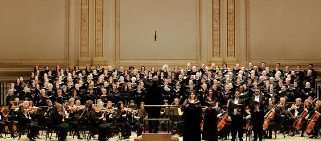|
Back
Bucolic and Pyrotechnics New York
Isaac Stern Auditorium, Carnegie Hall
02/06/2017 -
Maurice Duruflé: Requiem, opus 9
Joseph Haydn: Missa in angustiis (Lord Nelson Mass), Hob.XXII.11
Vanessa Vasquez (Soprano), Abigail Fischer (Mezzo-soprano), Zach Borichevsky (Tenor), Sava Vemic (Bass)
New York Choral Society and Orchestra, David Hayes (Music Director and Conductor)

Was the program New York Choral Society presented on February 6 at Carnegie Hall an attempt to show two dissimilar ways of worshipping God by its Catholic composers or was it to juxtapose these two possibilities: one composer, Maurice Duruflé, known for about the smallest output of works published and the other, Joseph Haydn, whose fourteen masses were only a small fraction of a huge body of compositions? Regardless of the programmatic intentions, here the venerable New York Choral Society under its Music Director David Hayes presented two scores that had little in common yet were both attractive, each in its own way.
Maurice Duruflé, known to the world mostly as a French organist, based his Requiem (composed between 1941 and 1947) to a large degree on an equally serene requiem that was much more famous, that by Gabriel Fauré. Unlike the well-known requiems of Berlioz or Verdi, Duruflé omitted a Dies Irae section. Similarly to Fauré’s famous model, it omits or includes the same portions of the Latin requiem mass. And Duruflé, like Fauré before him, actually earned his living as an organist: that probably explains the continuous presence of the organ in the score. The other great influence on Duruflé was Gregorian chant, familiar to him since childhood from having attended services at the Rouen Cathedral. Another similarity with Fauré was the spare use of soloists and Duruflé uses only one; here the section Pie Jesu was sung by mezzo-soprano Abigail Fischer. The version of this Requiem heard at Carnegie Hall was one of three extant, this time for chamber orchestra: organ, strings, trumpets, and harp. One of the most memorable moments came in the quietest, most tranquil section of the work, Pie Jesu; here we heard only organ, a beautiful cello solo played by David Heiss, and our soloist Ms. Fischer, who acquitted herself very nicely in that prayer.
It is possible that the otherwise excellent vocal group had an easier task singing the crisper lines in the Haydn composition: in Duruflé I had slight difficulty hearing the consonants but this may have been a merely a matter of acoustics. It is also possible that the quiet, pacific character of the work and reliance on ancient plainsong and modal scales makes this Requiem a composition that is lovable, yet a bit lackluster.
Haydn’s Missa in angustiis (from 1798), heard in the second half of the program, was a different matter entirely. It is considered a high point in Haydn’s liturgical output and in vocal writing rivals any of the operatic music from the era. It is commonly known as the “Lord Nelson Mass”, not entirely a misnomer, since at the time Haydn was following the events of Lord Nelson pursuing Napoleon. But from the onset there is also some of the martial character and orchestration recognized in many of his symphonic works and that alone might have evoked the military connotation that has taken hold to this day. Haydn did however come in contact with the Admiral who two years after the composition of the Mass visited Prince Esterházy in Eisenach and attended the performance of the work given in his honor.
One is accustomed to Mozart’s “cruelty to singers” in his vocal works, but in this Mass Haydn has not much mercy on them either. Nor is drama in short supply; there is symphonic sweep to the structure. The demands that Haydn puts on his singers are displayed from the very start and here in her opening Christe eleison and Gloria in excelsis Deo the soprano Vanessa Vasquez impressed with her fearless attack of the high tessitura passages soaring above the ensemble. She made a similarly good impression in Et incarnatus est in the Credo section. The young Serbian bass Sava Vemić showed strength, touching emotion, and a warm timbre in the Qui tollis peccata mundi. The two other soloists, Ms. Fischer and tenor Zach Borichevsky, had less exposed parts but their contributions were valuable.
I found quite a few echoes of Mozart, both operatic and liturgical, in the Haydn score which packs a lot of passion and drama; he also shows himself to be a master of counterpoint. Unfazed by a lack of the full complement of orchestral forces at his disposal, Haydn relied to great effect on his available trumpets and timpani. Throughout the evening the most important protagonist was still the excellent choir who sang with enthusiasm, self-confidence and style, and handled all the obstacles thrown at them, especially in the difficult virtuoso writing of the Haydn.
Since its inception in 1959 the New York Choral Society remains one of the most distinguished in the city. Over the years it has mastered an enormously varied repertory and performed all over the world. Maestro David Hayes took over the reins of the ensemble in 2012 and it looks as though he is continuing the great tradition established by his predecessors Robert De Cormier (1970-1987) and John Daly Goodwin (1987-2012). In an effort to strengthen its position in the New York musical firmament, the New York Choral Society has just appointed its first-ever professional Executive Director, Patrick Owens.
Roman Markowicz
|